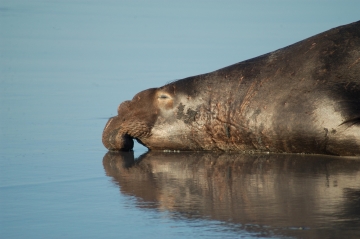701423_Nap Time_full resolution_360 px width.jpg

Northern elephant seals spend several months at sea to feed. Researchers used sensors on their heads and found out that the seals sleep by falling hundreds of feet for about 10 minutes at a time. Credit: Robert Schwemmer, NOAA.
When we talk about “falling asleep,” we don’t usually mean it literally. For Northern elephant seals, though, it is literal—they sleep while falling through the ocean. You can’t help but wonder if they dream about falling, too.
Northern elephant seals live along the coast of California. They can be up to 13 feet long, and weigh a couple of tons. The seals spend seven or eight months a year at sea, foraging for food. They spend the remaining months on shore, where they breed and rest up for the next year’s journey.
When they’re on shore, they sleep for 10 hours a day or longer. But researchers in California wondered how they slept at sea. So they strapped “swimmer’s caps” on the heads of 13 young females in Monterey Bay. Instruments recorded depth, motion, and heart rate. And for the first time, they also recorded brain activity.
Those recordings showed that the animals took “power naps” of about 10 minutes. At depths of several hundred feet—below the “danger zone” where they’re likely to come across predators—the seals stopped, began to glide, then fell into a deep sleep. While they slept, they spiraled downward like leaves fluttering from a tree. After catching a few Zs, the seals woke up and swam to the surface.
The researchers compared their findings to depth and motion profiles obtained from hundreds more seals over the decades. That showed that ocean-going elephant seals sleep just two hours a day—a few power naps to keep them going.

